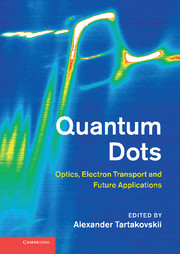Book contents
- Frontmatter
- Contents
- List of contributors
- Preface
- Part I Nanostructure design and structural properties of epitaxially grown quantum dots and nanowires
- Part II Manipulation of individual quantum states in quantum dots using optical techniques
- Part III Optical properties of quantum dots in photonic cavities and plasmon-coupled dots
- Part IV Quantum dot nano-laboratory: magnetic ions and nuclear spins in a dot
- Part V Electron transport in quantum dots fabricated by lithographic techniques from III–V semiconductors and graphene
- Part VI Single dots for future telecommunications applications
- Index
Preface
Published online by Cambridge University Press: 05 August 2012
- Frontmatter
- Contents
- List of contributors
- Preface
- Part I Nanostructure design and structural properties of epitaxially grown quantum dots and nanowires
- Part II Manipulation of individual quantum states in quantum dots using optical techniques
- Part III Optical properties of quantum dots in photonic cavities and plasmon-coupled dots
- Part IV Quantum dot nano-laboratory: magnetic ions and nuclear spins in a dot
- Part V Electron transport in quantum dots fabricated by lithographic techniques from III–V semiconductors and graphene
- Part VI Single dots for future telecommunications applications
- Index
Summary
Semiconductor quantum dots (QDs) have been extensively researched in the past 20 years or so. Over this period, the field has been stimulated by various motivating factors from fabrication of low-threshold temperature-insensitive QD lasers to the use of single spins for quantum computing and single dots for medical markers. In the past decade, refinement of fabrication and experimental techniques enabled researchers in the field to routinely use single QDs to access and control single electrons and holes and their spins, and to generate non-classical light. The focus of this book is on control of optical and transport properties of single and few QDs. The remarkable progress in this fast-developing field in the past three to five years is reported.
The term “quantum dot”, widely used from late 1980s, usually refers to a semiconductor nano-structure. Typical sizes of a quantum dot range from a few nanometers in colloidal dots (also referred to as nano-crystals) to a few hundred nanometers in lithographically fabricated electrostatic structures, so that on average they contain from 103 to 106 atoms. The small physical size is the main common characteristic feature of quantum dots made from different materials and using various fabrication methods. It is usually combined with additional methods for electron energy engineering, for example, surrounding the dot with a higher band-gap semiconductor, applying gate-voltage creating a higher potential barrier around the dot, etc. This gives rise to the most important basic property of QDs: the motion of electrons and holes in QDs is suppressed in all three dimensions.
- Type
- Chapter
- Information
- Quantum DotsOptics, Electron Transport and Future Applications, pp. xv - xviiiPublisher: Cambridge University PressPrint publication year: 2012



